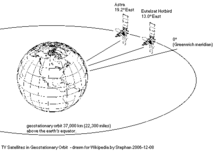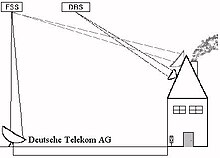Broadcasting satellite
A broadcast satellite , or television satellite (also English Direct Broadcasting Satellite or Direct Broadcast Satellite , DBS for short ) is a communication satellite for the transmission of broadcast content . Broadcast satellites are used both for satellite reporting and for transmitting broadcast programs to viewers (often also by feeding them into a cable television network ).
The offer to transmit programs directly to the end recipient is called Direct to Home , or DTH service for short .
In Europe almost only geostationary satellites are used as broadcast satellites . This is usually not a single satellite , but a satellite group that consists of several satellites and that is combined into a satellite position, actually orbital position .
technology
The radio and television satellites are relay stations or converters that automatically receive radio signals and transmit them again on a different frequency. In satellite technology, one speaks of transponders .
The width of the individual transponder channels in pure television satellites for analog reception was matched to the bandwidth required for an analog television program and is therefore normally 27 MHz. In the Astrasystem , a channel width of 33 MHz is used in the digitally used 12 GHz range because it allows a higher data transmission rate than the narrower transponders originally intended for analog transmissions in the 11 GHz range. However, these are now also used digitally.
For television satellites, which were originally planned as so-called television distribution satellites to supply cable networks with analog programs, a channel width of 36 MHz was chosen because of the inevitable quality losses in these long networks with their many amplifiers to increase the picture quality. However, some of these satellites also became important for direct satellite reception. There, however, the higher bandwidth of the signals played no role.
Some of these satellites had such broadband transponder channels (72 MHz or more) that even two analog TV programs could be broadcast over each channel.
The television satellites use, in order to better utilize the available frequency range , like communication satellites with successive channels different polarization , whereby the channels can partially overlap. The rotation of the plane of polarization caused by the Faraday effect when passing the ionosphere is negligible because of the very high transmission frequency.
history
In Europe, it was decided at the end of the 1970s that broadcast satellites should only supply the respective country of origin with television and radio programs. Each country, together with other countries, was assigned an orbital position , exclusive five frequencies, the polarization direction, the transmission power and an illumination zone tailored to the size and shape of the respective country . Compared to communication satellites, they had to have an extremely high transmission power per channel so that the viewer could get by with a parabolic antenna only 60 cm in size, despite the significantly poorer receiver at the time . The high-power television satellites planned in this way (so-called high-power DBS satellites) were to broadcast five additional television programs or a mixture of television and radio programs (several radio programs per channel) for the individual countries from the 1980s.
According to the plans laid down at the World Administrative Radio Conference 1977 (WARC 77), broadcast satellites should transmit in the area of the Ku band assigned to Broadcasting-satellite service and use circular polarization . In contrast, communications satellites or telecommunications satellites in the area of the Ku band called fixed satellite service and SMS band use linear polarization.
Each state was assigned five frequencies = transponders including an illumination zone in the BSS band (frequency range from 11.7 to 12.5 GHz) tailored to its country for its DBS satellites on a satellite position . The BSS band was again divided into a lower (11.7 to 12.1 GHz) and an upper half-band (12.1 to 12.5 GHz). Normally a state was assigned its five frequencies in one of these two half-bands. A television program or several radio programs could be transmitted via each transponder. In order not to interfere with the reception of other DBS satellite positions, the satellite positions of the DBS satellites had to be at least six degrees of longitude apart. For this purpose, up to eight different states have been assigned five frequencies on one satellite position, since just as many satellites can be stationed on one position. In order to be able to receive the satellites at all with the technology of the time with the small satellite antennas with a diameter of 90 cm, they had to use extremely high transmission power per transponder. A power density of −100 dBW / m² should be achieved in the center of the footprint that surrounds the respective country and −103 dBW / m² at the edge of the footprint. The satellites could only be aligned to the target area with an alignment accuracy of 0.1 °, which is why the footprint enclosed the state borders with a minimum distance of 70 km to prevent the peripheral areas of the state from being no longer in the footprint due to inaccuracies in the orientation lay. In a zone around the footprint with a power foot density of up to −111 dBW / m², the required antenna diameter should increase to 180 cm (it was also permitted for a state to use frequencies not used for satellite transmissions terrestrially).
The high transmission power required for this high flux density on the ground meant that satellites with high transmission power were very large, heavy and expensive and that most countries could not / would not afford one. Most of these satellites therefore already failed in the planning phase. Only a few, such as the TV-SAT and TDF project financed by the German federal government and the French government , were implemented, but then failed in the audience's favor due to the low number of programs and the new television standard D2-MAC , which were introduced at the same time should. The TV-SAT, TDF, Tele-X - and Marco Polo satellites tracked the concept of Direct Broadcasting Satellite, back in office as German broadcast satellite called.
Before these satellites could be launched, signal converters with much lower noise levels were developed with HEMT amplifiers . With the DBS satellite, this also enabled reception behind window panes with 40 cm antennas. This also enabled reception with 60 to 90 cm antennas in the area around the coverage area.
Low-power satellites such as B. DFS-Kopernikus , could not prevail because slightly larger antennas are required for their reception than for the satellites with medium transmission power. With these an antenna with a diameter of 60 to 90 cm was sufficient for reception.
So finally satellites with medium transmission power, such as Astra , prevailed. These transmit in the frequency range and with the polarization directions that were originally only allowed to be used by communications satellites. That is why they were initially officially referred to as communications satellites . Because the orbital positions for communications satellites are only assigned to one country at a time and the entire frequency range intended for communications satellites is available, these television satellites can broadcast their television and radio programs over dozen of channels. However, this is only possible because the transmission power per channel is not as high as that of the high-performance satellites and so the power generated by the solar cells is sufficient for these many transponders.
Originally, communication satellites that worked in the FSS and SMS area of the Ku band were only intended to be used for transmitting messages or for feeding programs to cable networks or SNG . Because of the larger number of programs, radio reception via satellites in the FSS band prevailed. Today, the entire Ku band is used by these communications satellites.
See also
Individual evidence
- ↑ a b Eberhard Spindler, The great antenna book: Calculation and self-construction of receiving antennas, Munich Franzis 1987, edition in Verl. Technik, Berlin ud T .: Spindler, Eberhard: Antennen ISBN 3-7723-8761-6
- ↑ Karl-Otto Saur: Klipp und klar, 100 x television and radio . Bibliographisches Institut AG, Mannheim 1978, ISBN 3-411-01711-2 , page 68


